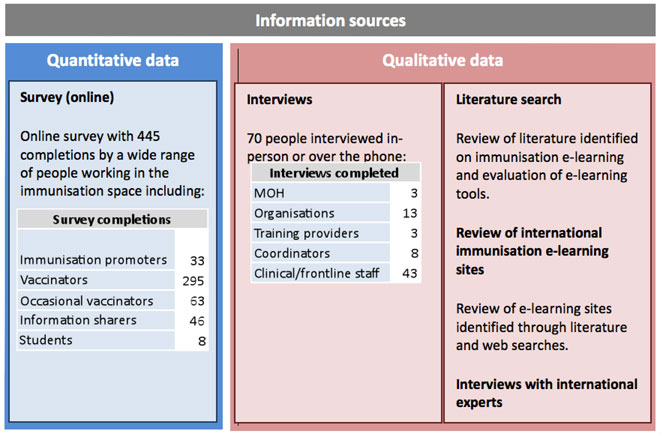Project Description
This research provides information about whether the Ministry of Health’s current e-learning tool is fit for purpose and how it could be improved by either updating the existing tool or through redevelopment. The research also explores how the tool could be used by professional bodies as part of their professional development programmes.
Approach to Information Collection
The information collection for this report was designed to give all immunisation stakeholders the opportunity to provide their views. For the purposes of this research we have grouped immunisation stakeholders into the following categories:
- Immunisation promoters – health professionals who promote immunisation and provide support and training to others in their locality such as immunisation trainers (IMAC and WONS), immunisation coordinators (DHBs), PHO advisors, nurse educators (lead practice nurses);
- Vaccinators – health professionals who regularly give vaccinations such as practice nurses, public health nurses (including district nurses, school based nurses, outreach services), GPs, Paediatricians, After Hours Medical Centre staff;
- Occasional vaccinators – health professionals whose role is primarily sharing information about immunisation but who also may vaccinate such as midwives or pharmacists;
- Information sharers – health professionals and other groups who share information about immunisation but who do not generally vaccinate, such as Plunket, PAFT, Well Child Services, community support workers, kaiawhina; and
- Students.
Information was collected through a review of the literature, interviews and an online survey of immunisation stakeholders, as detailed below.

Stakeholders’ Learning Needs
Respondents to the survey were asked how confident they felt in talking to families about different aspects of immunisation. Overall, more respondents said they felt confident in talking about the benefits of immunisation and fewer that they felt confident in talking to families who did not wish to immunise their children. As expected, immunisation promoters and vaccinators said they felt more confident in talking about all aspects of immunisation than occasional vaccinators and information sharers.
When asked about what information would be helpful to improve their confidence in talking to families about immunisation and what topics were important to include on a MOH e-learning site, immunisation stakeholders identified the following topics:
- Communicating information about immunisation – for all stakeholders
- How to have conversations with families about immunisation to explain the process and to seek consent;
- How to have conversations with families who were thinking about declining to have their children immunised including how to “de-bunk the myths”; and
- Cultural competency – how to communicate with Māori whānau and with other ethnic groups.
- Basic information about immunisation and diseases – mainly for occasional vaccinators and information sharers
- How the National Immunisation Programme works;
- What diseases immunisation protects against and that these diseases have not gone away;
- What immunisation achieves;
- Why it is good for children to be immunised; and
- Why one injection is not enough and why children need to be vaccinated on time.
- Basic information about vaccination – for occasional vaccinators
- How to vaccinate with examples of “best practice” especially in early childhood vaccination, for example how to hold a baby while vaccinating; and
- Where to put the needle and the difference between intramuscular and intradermal vaccination.
- Technical information – for vaccinators and authorized vaccinators about
- Vaccines, vaccine composition;
- Contraindications;
- Cold-chain
- Recording information about immunisation;
- Adverse events;
- Understanding immunisation for special cases;
- Recording, tracking and reporting adverse events; and
- Overseas schedules and catch-ups.
